SpearrinLab
laser spectroscopy, reacting flows
Timeline
2022
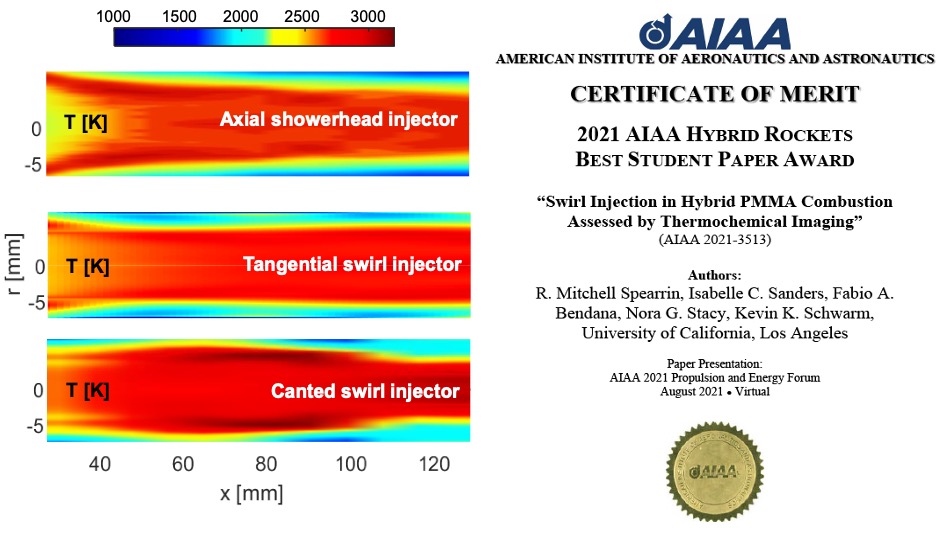
PhD student Isabelle Sanders and co-authors were recognized by AIAA with a best student paper award in the Hybrid Rockets technical area for their work studying swirl injection effects on hybrid PMMA combustion.

Professor Spearrin along with postdoc Chuyu and students Anil and Isabelle attended the International Symposium on Combustion in Vancouver, BC, Canada. Contributions included a poster on methyl methacrylate kinetics and oral presentations on hypergolic propellant detonation, 3D spectroscopic imaging, and solar-thermal methane pyrolysis.

Bruin alum and NASA astronaut Megan McArthur visited UCLA for an in-person Q&A co-hosted by Professor Spearrin, UCLA Rocket Project and the Samueli School of Engineering after her mission to the International Space Station.

PhD student Christopher spents several months at the NASA Ames Research Center in early 2022 as part of his NASA Space Technology Research Fellowship. He employed diagnostic techniques for measuring CO and CO2 in tehrmal and chemical non-equilibrium in NASA's Electric Arc Shock Tube (EAST) facility. This test series replicated very high enthalpies associated with the Mars2020 entry conditions.

PhD student Kevin Schwarm traveled to Indianapolis, Indiana for the Fall 2022 Internal Combustion Engine Forward Technical Conference to present his work on Cycle-Resolved Emissions Analysis of Polyfuel Reciprocating Engines via In-Situ Laser Absorption Spectroscopy.
Lab research on solar-driven methane pyrolysis for graphite and hydrogen production with Professor Tim Fisher and Yves Rubin was highlighted by the California NanoSystems Institute. Great work by our postdoc Chuyu and graduate student Barathan!

Long overdue in-person graduation for the first PhDs of our lab (Daniel, Chuyu, and Fabio) and for our most recent grad Anil. Well-deserved recognition in completing the long road to an Engineering PhD!
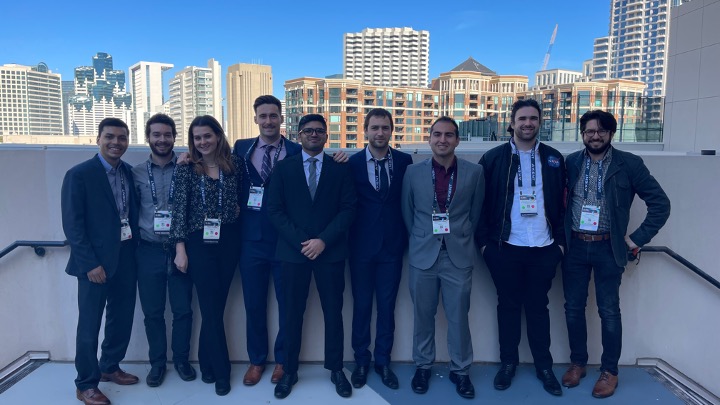
Grad students Anil, Isabelle, Kevin, Alex, Nick, and Christopher came out in force to the AIAA Scitech 2022 Forum in San Diego, presenting a wide range of our research including hybrid rockets, Mars entry, UAV sensors, hypergolic detonation, and additive manufacturing.
2021

Our annual lab BBQ made a comeback and set a new record for attendance! We celebrated graduations, new jobs, and the opportunity to reunite in person with lab members new and old.

PhD students Anil Nair, Alex Keller, and Nick Kuenning led a successful hot-fire test campaign at our Mojave propulsion test facility. These tests will help to advance research in rotating detonation rocket propulsion with particular focus on hypergolic space-storable propellants and additive manufacturing.

PhD student Kevin Schwarm conducted tests in the UC Blodget Research Forest near Lake Tahoe alongside collaborators from OKSI, UC Berkeley, and UC Riverside. They deployed optical spectrometers on drones to characterize carbon emissions during controlled burns.
Media Coverage: MSNBC and UCLA Newsroom

Our collaboration with JPL under the Strategic University Research Partnerships program was featured on the partnership website. This multi-year project employed laser absorption spectroscopic sensing of combustion species and temperature in the reaction layer of a hybrid rocket motor.

Anil Nair and co-authors were recognized by AIAA for Best Paper in Pressure Gain Combustion at the Propulsion and Energy Forum for MHz-rate sensing in rotating detonation rocket engines.
2020

UCLA researchers collaborate with Opto-Knowledge Systems, Inc. and the Air Force Research Laboratory to develop a high-speed optical sensing method for time-resolved temperature, pressure, and species measurements at up to 3 MHz measurement rates to analyze a methane-oxygen annular detonation rocket combustor. RDREs have potential to dramatically improve rocket fuel efficiency.

Although the COVID-19 pandemic required physical distancing, weekly virtual lab group meetings have helped us mitigate stresses of social distancing (and share some laughs along the way)

Graduate students Daniel Lee, Chuyu Wei, and Fabio Bendana are the first class of students in our lab to complete their Ph.D. requirements and graduate from UCLA this summer and fall (2020)! They were critical in building up our lab facilities and capabilities and will be taking new positions as experimental scientists and postdoctoral scholars. This photo goes back to the first year they were in our lab (4 years ago); they went to Princeton together for a workshop in combustion science and engineering.

Isabelle Sanders was selected as a 2020 Natural Sciences and Engineering Research Council Scholar, the top distinction in Canada for graduate students in science and engineering! Her research focuses on hybrid rockets as a safer and more cost-effective means for in-space propulsion. Her current work involves thermochemical imaging of the reaction layer in hybrid rockets using laser absorption tomography aimed at improving motor design and combustion performance.
2019
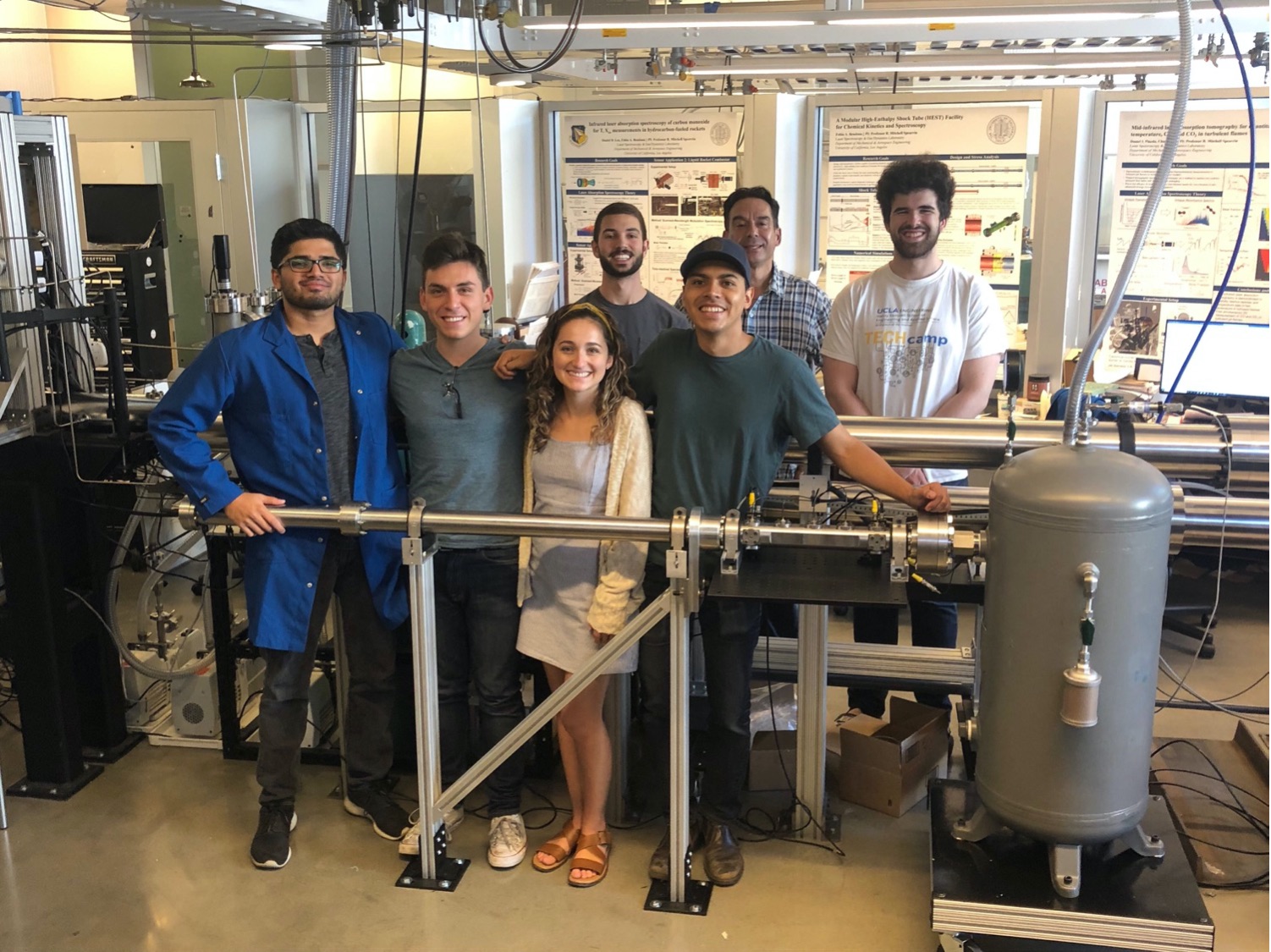
Our detonation impulse facility was completed after a year and a half of analysis, design, manufacturing, and testing! The project involved a team of graduate and undergraduate students who, with the help of UCLA's R&D Machine Shop, developed the facility completely in house. We recorded our first detonation, which reached speeds of 2500 m/s!

Our lab has begun two new collaborative research projects using our solid fuel combustion facility. A collaboration with NASA JPL aims to improve the performance/efficiency of hybrid rockets and provide insights into hybrid combustion physics and our collaboration with WPI aims to better understand toxicity of fires at the wildland-urban interface.
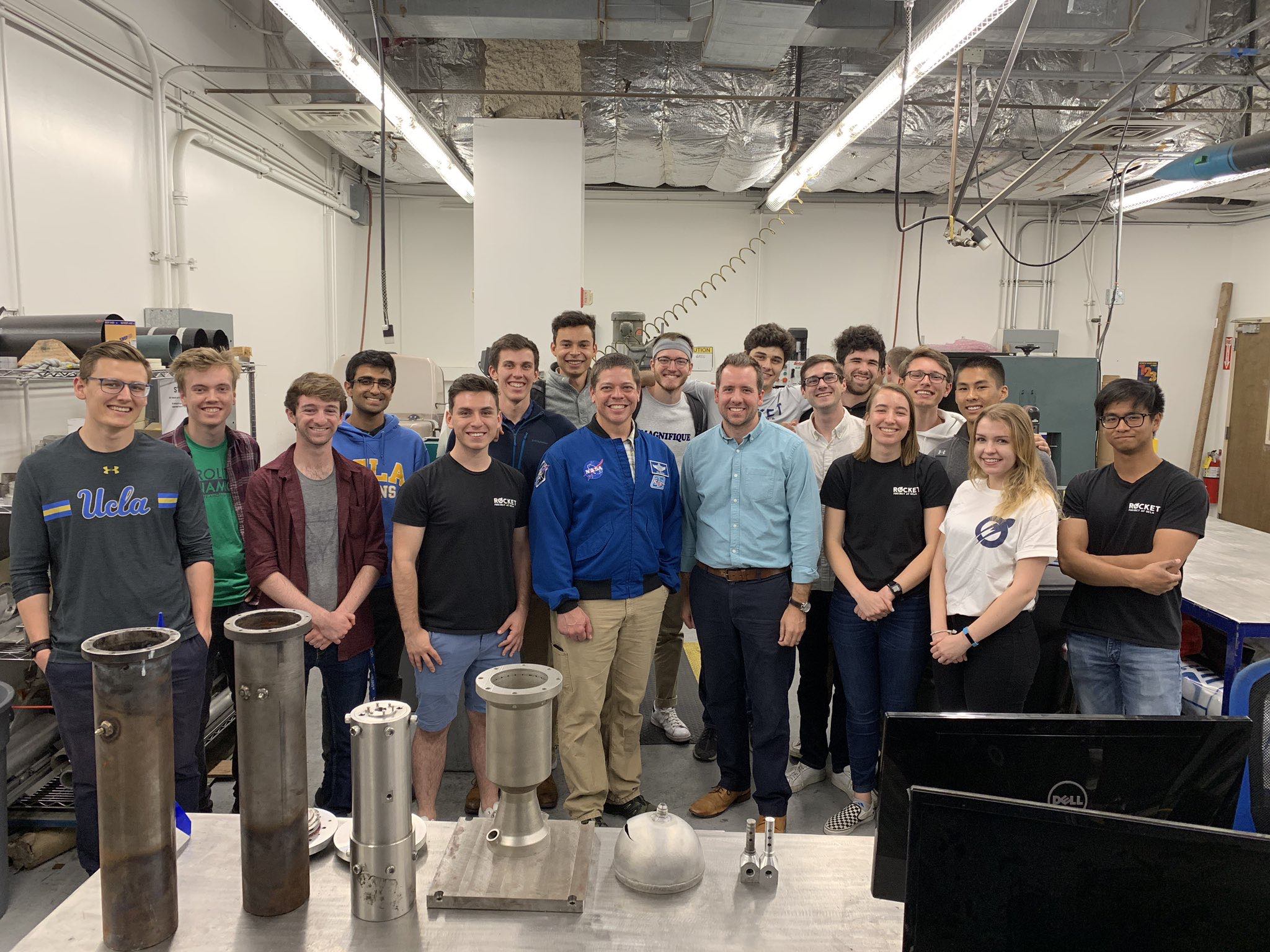
NASA astronaut, Bob Behnken, toured the UCLA engineering facilities with Prof. Spearrin and discussed the value of project-based learning with engineering students. Several UCLA alumni are actively working on the SpaceX rocket that will send Bob Behnken to space! Udpate: Dr. Behnken was one of two astronauts in the first SpaceX crew to launch to the international space station on May 30, 2020. His successful mission marked America's return to space launch since the retirement of the Space Shuttle in 2011, and SpaceX's first crewed mission.

Professor Spearrin traveled to Washington D.C. as a UCLA representative to U.S. Congress on behalf of the National Science Foundation to share his research and the impact of federal funding in science and engineering. Pictured here on Capitol Hill, Prof. Spearrin spent the day meeting with congressional representatives, concluding with a research exposition that brought together scientific researchers from across the country.

China Hagström, Fabio Bendana, and Josue Castillo are pictured in front of the Mars 2020 Perseverance Rover at NASA JPL after presenting their research on the spectroscopic analysis of hybrid rocket combustion efficiency (left). Christopher Jelloian spent the summer with the Aerothermodynamics Branch at NASA Ames Research Center studying numerical models of planetary entry (right).

Our lab has begun a collaborative effort with UCLA Medical Center to develop a new breath analysis technique to monitor the state of ketosis of a patient during treatment for traumatic brain injury. It is known that a ketogenic diet can help mitigate epileptic seizures after brain injury, but children on a keto diet regiment can also become too ketotic and enter a dangerous state of keto-acidosis. The current standard for clinical ketone monitoring requires a blood sample. This collaborative project with the Ketogenic Diet Program of the Adolescent Epilepsy Center at UCLA aims to create a less-invasive device that enables more regular ketone monitoring.

Several students (undergraduate and graduate) presented their research at the U.S. National Combustion Meeting in Pasadena, CA and enjoyed a banquet under the Space Shuttle Endeavour at the California Science Center.

Prof. Spearrin's new MAE 150C Combustion and Energy Systems course launches! The course covers both fundamentals of combustion, including chemical kinetics and transport phenomena in reacting flows, and thermodynamic aspects of practical energy systems (gas turbines, piston-engines, rockets). Combustion is also discussed in the broader context of renewables and environmental impacts.
2018

Construction of a new propulsion test facility for UCLA begins in Mojave, CA. The facility will provide unique rocket test and launch infrastructure for research and educational activities. The facility will be directed by Dr. Spearrin.

Kevin Schwarm - National Defense Science and Engineering Graduate Fellowship: Multi-Physics Analysis of Reacting Sprays Relevant to Rocket Propulsion and Power GenerationChristopher Jelloian - NASA Space Technology Research Fellowship: Non-Equilibrium Heat Transfer During Mars Entry Using Advanced Laser Diagnostics

Dr. Spearrin named a 2019 recipient of the prestigious Air Force Office of Scientific Research Young Investigator Program (AFOSR YIP) Award for development and application of a novel laser-based imaging method for the study of reacting fluid dynamics relevant to advanced propulsion.

The UCLA Rocket Project launches a liquid bi-propellant rocket (LOx-ethanol) to 12,000+ ft. in preparation for the FAR-Mars competition. The UCLA Rocket Project is advised by Dr. Spearrin.
2017

This five year grant will support his research using spectroscopy to understand the chemistry and physics of combustion at high pressures. Knowledge learned from the studies will be applied to the next generation of ultra-efficient engines. The award will also support project-based educational activities led by Dr. Spearrin.

Dr. Spearrin's new MAE 259A Spectroscopy and Molecular Gas Dynamics course launches. The course is designed to teach graduate students in engineering the fundamentals of light-matter interactions and gas dynamics at the molecular state.

Dr. Spearrin's new design-build-launch curriculum for the MAE 157A aerospace capstone class gets featured in an article by UCLA Engineering News. The team-based course taken by seniors in aerospace engineering involved the design, analysis, manufacturing, and testing of mid-power rockets and culminated in a launch competition in the Mojave desert.

The Spearrin Lab joined members from the Reaction Research Society (RRS) in a launch demonstration of several zinc-sulfur rockets out in Mojave, CA. The Reaction Research Society is the oldest continuously operating amateur experimental rocket group in the United States.

Our lab begins a new collaboration with the University of Southern California's Combustion and Fuels Laboratory to study turbulent premixed jet flames using advanced laser diagnostics.

Graduate researchers Daniel Lee and Fabio Bendana spent part of their summer working on a liquid rocket engine test rig at AFRL in Edwards, CA. Together they developed new laser diagnostic techniques to measure species and temperature at the extreme temperatures and pressures of an LRE combustion chamber.
2016
2015
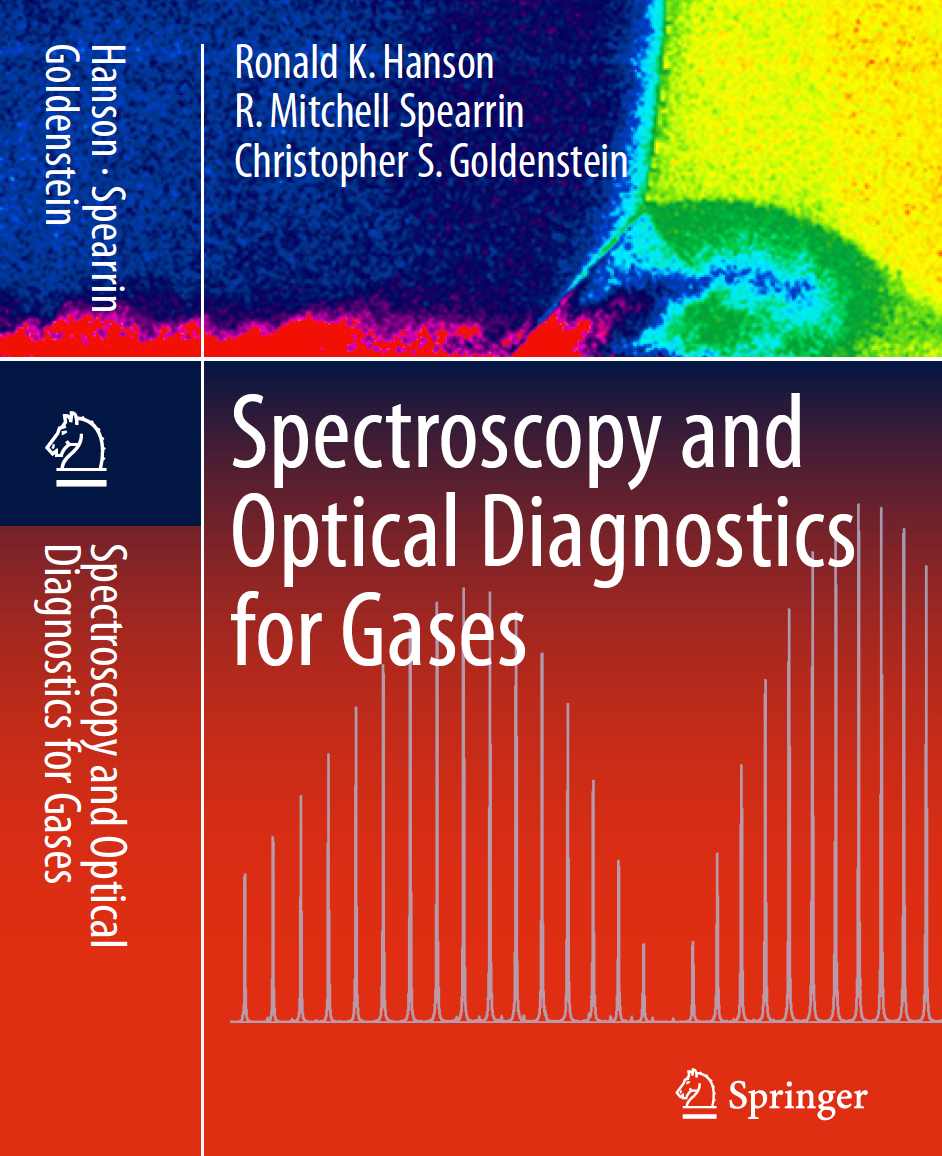
Dr. Spearrin co-authors a new textbook on applied spectroscopy, published by Springer. The text provides an introduction to the science that governs the interaction of light and matter (in the gas phase) for the purpose of providing engineers, scientists, and aspiring students the basic knowledge to (1) exploit the light-matter interaction to develop quantitative tools for gas analysis (i.e. optical diagnostics) and (2) to understand and interpret the results of spectroscopic measurements.

Stanford Medicine magazine features an article on the extension of laser absorption spectrosopy for breath diagnostics, highlighting an emerging area of cross-disciplinary research and profiling Dr. Spearrin and his colleagues who have driven recent progress in the field with an aim toward addressing pediatric emergency conditions.





